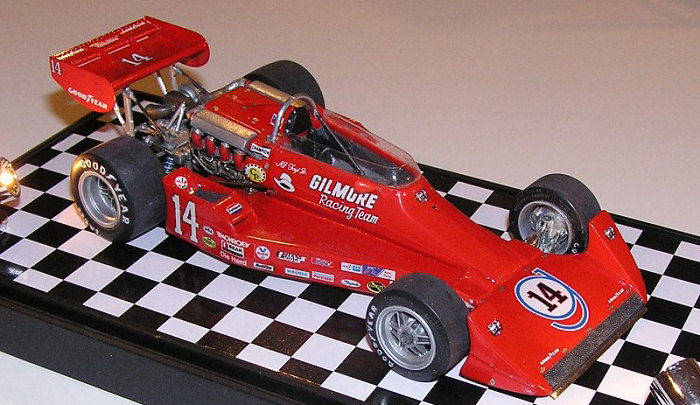
Bill Jorgensen 1/24 1977 Foyt/Coyote
| KIT: | |
| KIT #: | ? |
| PRICE: | $65.00 |
| DECALS: | I guess none come with the kit, Ed |
| REVIEWER: | Russ Bundy |
| NOTES: | Resin; Indycals decals used |

| HISTORY |
A.J. Foyt and The Indianapolis 500:
After winning three Indianapolis 500 races during his first ten years, many thought it was only a matter of time before Texas Tough Man A.J. Foyt would win his fourth, making him the first driver to do so. Then something funny happened. Foyt wanted to build his own cars and win his fourth 500 in a car he’d built himself. The years passed, and passed. It became a joke around Gasoline Alley at the fabled Brickyard. When his former Chief Mechanic, George Bignotti, won his fourth 500, after he and Foyt parted ways in 1965, many thought Foyt would never win that fourth 500, a win Foyt wanted so desperately. Former driver and current team owner, rival legend Parnelli Jones once said, “If Foyt would have just stuck to driving and not building his cars, he would have won the 500 at least six times already.”
Every
year, May would begin at Indy with many questions. What car would Andy Grantelli
try this year? Another form of the famed Novi? Another Turbine? Who will Mario
Andretti drive for? What kind of car will Foyt bring out to try and win his
fourth 500, only to have it breakdown? Years had passed since A.J. had won his
third 500. Each year he tried something different. Each year, he would qualify
and run well, only to have the car falter in the race. In 1972 Foyt’s car w ouldn’t
even start at the beginning of the race!
ouldn’t
even start at the beginning of the race!
Just when the jokes became as familiar at Indianapolis as Jim Nabors singing, “Back Home Again in Indiana”, Jim Gilmore joined forces and started to sponsor Foyt’s team, while Bob Riley designed a new car, powered by a reworked Ford Four-Cam Engine called a Foyt Engine. Foyt’s father became his crew chief, and the 1974 Coyote was an awesome racing machine. Suddenly, A.J. Foyt was taking poles and winning races. Everywhere. Everywhere but at the one track he wanted to win at so badly, Indianapolis. The new Coyote/Foyt car took the pole in 1974 and 1975. It led both races until botched pit stops or mechanical failure forced him out, though he finished in the top three in 1975 and 1976. By the 1977 race, Foyt and his car were considered wondrous things of the past, but not a force to be taken seriously for the victory he wanted so much.
Putting his car on the inside of the second row of thirty-three, 42-year old A.J. Foyt started the 1977 500 working his way up slowly. Contented to stay in the top five and letting others lead the race, Foyt watched as Al Unser Sr. and Gordon Johncock would take turns leading the race. Foyt moved his way into the lead on lap 27. From that point on, it was a two-car race. Foyt in his tried and true Coyote powered by an engine he built versus Gordon Johncock in another car designed by Bob Riley called a Wildcat, with a powerful turbo-charged Offenhauser engine built by Foyt’s former chief mechanic George Bignotti.
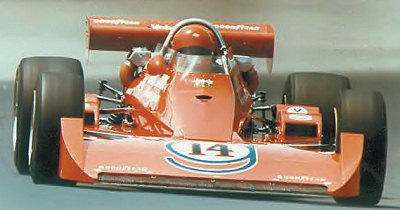 Lap
after lap they ran. It seemed it was going to be a two-car battle until the end.
Johncock pitted on lap 180, for a moment giving the lead back to Foyt. Two laps
later, Foyt came in for his final pit stop. When Foyt came back on the track,
Johncock had an 18-second lead. Foyt quickly cut it down to a 12-second lead.
When everyone was standing for what was going to be an epic battle between two
racing legends, it all came to a stop. Coming out of turn four, Johncock
suddenly veered to the inside of the main straightaway and was slowing down. He
turned the Wildcat onto the grass of the turn one infield with a broken
crankshaft. The engine had quit! “I thought I had it in the bag. The car was
running so beautifully. We had turned the fastest leading lap of the race on lap
178. Then, it was over. I pulled the car into the infield and went into the
creek and soaked my head.” Foyt slowed, making sure he saved his engine. With
the disappointments during the ‘75 and ‘76 500’s, Foyt wanted to make sure he
got across the finish line and into Victory Lane. As the laps ran down, the
Indianapolis crowd grew louder! Foyt had finally done it! He had his fourth 500
victory, becoming the first man to do so. And he did it in a car he had built
with an engine named after him. The Coyote/Foyt was headed to the Indianapolis
Hall of Fame Museum.
Lap
after lap they ran. It seemed it was going to be a two-car battle until the end.
Johncock pitted on lap 180, for a moment giving the lead back to Foyt. Two laps
later, Foyt came in for his final pit stop. When Foyt came back on the track,
Johncock had an 18-second lead. Foyt quickly cut it down to a 12-second lead.
When everyone was standing for what was going to be an epic battle between two
racing legends, it all came to a stop. Coming out of turn four, Johncock
suddenly veered to the inside of the main straightaway and was slowing down. He
turned the Wildcat onto the grass of the turn one infield with a broken
crankshaft. The engine had quit! “I thought I had it in the bag. The car was
running so beautifully. We had turned the fastest leading lap of the race on lap
178. Then, it was over. I pulled the car into the infield and went into the
creek and soaked my head.” Foyt slowed, making sure he saved his engine. With
the disappointments during the ‘75 and ‘76 500’s, Foyt wanted to make sure he
got across the finish line and into Victory Lane. As the laps ran down, the
Indianapolis crowd grew louder! Foyt had finally done it! He had his fourth 500
victory, becoming the first man to do so. And he did it in a car he had built
with an engine named after him. The Coyote/Foyt was headed to the Indianapolis
Hall of Fame Museum.
Since 1977, two other drivers - Al Unser Sr. and Rick Mears - have joined A.J. Foyt as the only four-time winners of the Indianapolis 500, but Foyt became the first on that historic May 29, 1977.
The car sits quietly in the Indianapolis Hall of Fame Museum, or does it? Jim Gilmore said he had the car, The 500 Museum said that they had it, and then at an auction in the mid 1990’s A.J. Foyt sold a car he claimed was real car that had won in 1977. Which one was it? No one knows for sure, but the winning bidder was Tony George and that car now sits in the Indianapolis Hall of Fame Museum for all to see. How good was the Coyote/Foyt? It kept running at Indy for another year, finishing in the top ten and won the first road course race in CART history at Sliverstone, England in 1978.
| THE KIT |
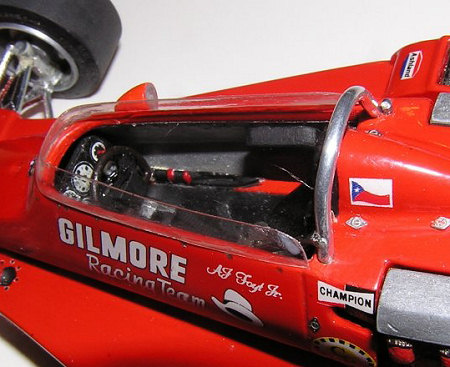 I was
so sure that Foyt was going to win that day I had on my cassette and recorded
the race off KLAC in Los Angeles. I edited out all the commercials and still
listen to the race. I have never made a secret that I am a HUGE A.J. Foyt fan. I
still am. I got to meet the man finally at the Long Beach Grand Prix one year.
He is everything you would expect from a racing legend. I wanted a model of this
car very badly.
I was
so sure that Foyt was going to win that day I had on my cassette and recorded
the race off KLAC in Los Angeles. I edited out all the commercials and still
listen to the race. I have never made a secret that I am a HUGE A.J. Foyt fan. I
still am. I got to meet the man finally at the Long Beach Grand Prix one year.
He is everything you would expect from a racing legend. I wanted a model of this
car very badly.
I first met Bill Jorgenson in 1992. At the time he was one of the very few making Indy Race Car Model Kits. Bill works hard to make sure he gets his patterns correct. Even today, if Bill sees that one of his kits isn’t just right, he’ll pull it from his catalog to make sure it is better. How many of the big plastic manufactures will do that? How many die-cast manufacturers do that? I can answer that…NONE! I began to pester Bill to do the Coyote.
Since the 1977 500, it was rumored AMT was going to do a Coyote/Foyt. Nothing happened. Then a company far ahead of its time, Precision Miniatures, came out with a 1/43 scale model of the 1977 Winner. A beautiful kit, full of detail and many parts, this kit was WAY ahead of its time. In white metal and vacformed plastic, this beautiful kit was very intimidating for a casual builder with not the greatest skills, which I was the first time I saw the kit. I now own two of those kits, and I have no intention of building them. They are worth a small fortune. Then SMTS out of England did a beautiful 1/43 scale Coyote. A Jewel! Perfect and easy to build! One sits with my other 1/43rd scale Indy 500 Winners and I urge you to get one and build it. Then, finally, after years of pestering, Bill Jorgenson came out with a 1/25th scale Coyote Foyt kit in 1993.
We don’t have to strain our aging eyes on those tiny, small parts! Bill’s kit consists of many, resin and white metal parts and a vacformed windscreen. Decals, accurate decals, are from Indycals and they are spot-on perfect! The great thing about Bill’s kit is you can build it out of the box, or go crazy like I did and wire the engine. Either way, you can’t go wrong. The resin Bill uses is easy to work with. Just take your time and check your sources. You’ll see how accurate and easy it is to build.
| CONSTRUCTION |
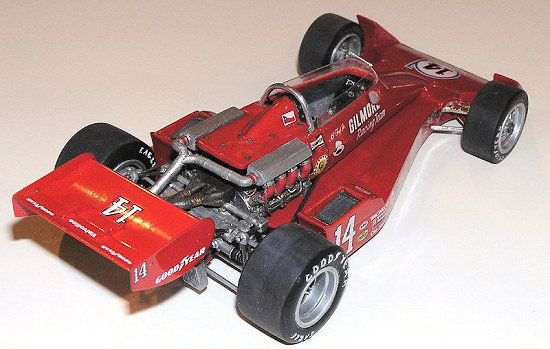 Bill’s kit interior gives you a seat, a dash and a steering wheel. More than enough to
make a great model. But I went crazy and added detail to the cockpit. I added
seatbelts, a stick shift and a pad that A.J. used on the left side of the
cockpit. That is the neat thing about these Jorgenson kits. You can get a great
looking model out of the box, or you can go crazy like I did. Bill has
engineered enough room for you do just that.
Bill’s kit interior gives you a seat, a dash and a steering wheel. More than enough to
make a great model. But I went crazy and added detail to the cockpit. I added
seatbelts, a stick shift and a pad that A.J. used on the left side of the
cockpit. That is the neat thing about these Jorgenson kits. You can get a great
looking model out of the box, or you can go crazy like I did. Bill has
engineered enough room for you do just that.
I wired my engine. The 1970’s Indy Cars had the engine out in the open. I took many photos of the engine on the car in the Hall of Fame Museum at the Indianapolis Motor Speedway, and went to work. Bill gives you a resin engine that is perfect for such a task.
With Bill’s engineering, the steering and suspension goes together easily for a modeler who’s done a few all-resin kits.
| COLORS & MARKINGS |
Painting:
I’ve
built two of these kits over the years. The first was one of Bill’s early
offerings. Because I used the wrong paint
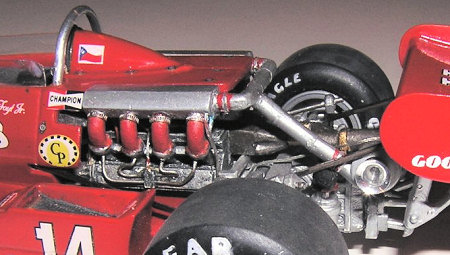 (enamel), over time it went bad. My
fault. I re-built it using the current offering from Bill. I now use Lacquer
paint and that means you have to primer.
(enamel), over time it went bad. My
fault. I re-built it using the current offering from Bill. I now use Lacquer
paint and that means you have to primer.
I used Dupi-Color red/orange lacquer paint. Foyt’s cars from 1967 on were painted a Ford Motor Company color, California Poppy Red. I thought about getting a tin of this paint, but I took a match to an auto-parts store and matched it with the much less expensive Dupi-Color.
Decals:
Mike Potaro of Indycals came out with a very accurate decal sheet. Mike’s products are very accurate as well as easy to use. Trimming them close, they presented no difficulty in getting them onto the model.
| CONCLUSIONS |
Bill took the time and effort to make sure he got the car as accurate as he could. When you’re finished, it sits just right. Some racecars look fast sitting still, and the Coyote/Foyt is one of them.
Bill
assures me that he will have more Coyote’s soon. You can find this and many of
Bill’s other kits on eBay. Just go to “Indy Resin” and you’ll find some of
Bill’s othe r kits. He will soon have the 77 Winner out again. He currently has
a 1967 Paxton/Turbine that Parnelli Jones drove and came ever so close to
winning the 1967 500. Soon, before you know it, you’ll have many kits of past
Indy 500 Champions and other Indianapolis 500 racecars to build.
r kits. He will soon have the 77 Winner out again. He currently has
a 1967 Paxton/Turbine that Parnelli Jones drove and came ever so close to
winning the 1967 500. Soon, before you know it, you’ll have many kits of past
Indy 500 Champions and other Indianapolis 500 racecars to build.
Now if only the major die-cast company offering of the 1/18th scale Coyote had taken the time and effort Bill has. Maybe it’s a good thing they didn’t. I would be poorer than I am currently, and I wouldn’t have taken the time to build this kit of a great car.
Kit courtesy of my wallet
February 2007
If you would like your product reviewed fairly and fairly quickly, please contact the editor or see other details in the Note to Contributors.